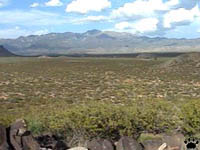
Desert around Three Rivers Petroglyphs site, New Mexico.
The Old New Mexico
The state of New Mexico is probably the most interesting part
of the USA for a historian. It has been occupied by a wonderful variety of cultures
and civilizations. The earliest archaeological evidence here dates back to 25,000
BC.

Clovis arrowhead,
Blackwater Draw,
New Mexico. |
The original Sandia Culture was replaced by the
Clovis people, big game hunters possibly of Caucasian type, who were apparently
responsible for the extinction of mammoths and other large mammals. |

Cro-Magnon arrowhead,
White Pigeon Cave,
France. |
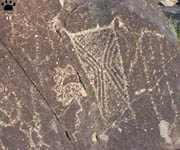 |
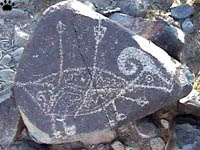 |
 |
| Rock art at Three Rivers Petroglyph
Site dates back to 100-1600 AD |
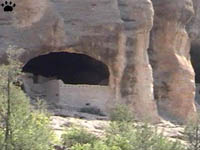
Cave houses of the Mogollon Culture, Gila Cliff
Dwellings National Monument, New Mexico. |
Then came the Folsom (9000-8000 BC), Cochise (the
first to introduce agriculture in the region), and the Mogollon (AD 300-1400)
cultures. The Mogollon people were the first to invent advanced pottery. |
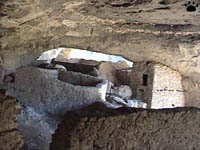
Cave houses of the Mogollon Culture, Gila Cliff
Dwellings National Monument, New Mexico. |
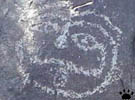 |
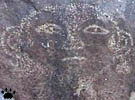 |
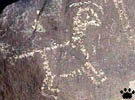 |
 |
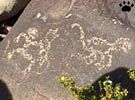 |
 |
 |
 |
| Petroglyphs of Three Rivers Site. |
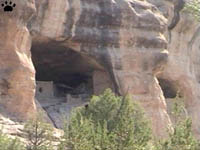
Gila Cliff Dwellings. |
They also developed original adobe and stone
architecture. The first Mogollon houses looked like rounded pits in the ground
with log roofs, but eventually one- and two-store buildings appeared. |

Gila Cliff Dwellings. |
 |
 |
 |
 |
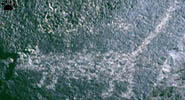
Rock art at Petroglyph Nat'l Monument, 1200-1600 AD, New Mexico. |
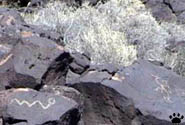 |
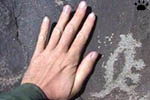
Rock art, Petroglyph National
Monument. |
As the Mogollon Culture was flourishing in southwestern
New Mexico, an even more spectacular civilization arose in the northwestern corner
of the present-day state and in the adjacent parts of what is now Colorado, Arizona
and Utah. |
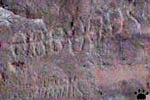
Centipede petroglyphs,
Canyon de Chelly, Arizona. |

Ruins of a typical Ancient Puebloan settlement,
Bandelier Nat'l Monument, New Mexico. |
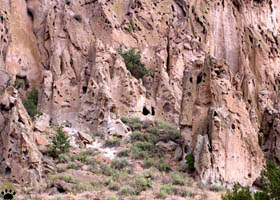
Skilled architects, the Ancient Puebloans still used caves as
houses and shrines. Bandelier Nat'l Monument. |
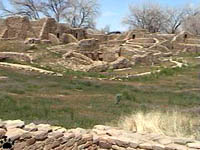
Ancient Puebloan settlement, Aztec Ruins Nat'l
Monument, New Mexico. |
Originally known as Anasazi ("ancient
enemies" in Navajo language), this culture is now called Ancient Puebloan.
In New Mexico, Spanish word pueblo (village) is mostly used for traditional
Native American settlements. |
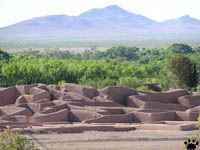
Influence of this culture was felt as far as Paquime,
in Chihuahua, Mexico. |
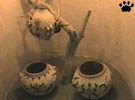 |
 |
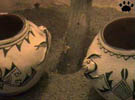 |
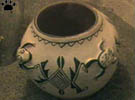 |
| Puebloan pottery, Bandelier Nat'l
Monument . |

Pueblo ruins, Mesa Verde Nat'l Monument, Colorado. |
Ancient puebloans lived in huge communal
houses; a city was often made up of just one such house the size of a modern apartment
building. |
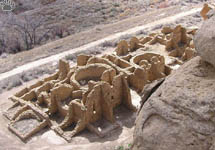
Kin Kletso ruins, Chaco Canyon, New Mexico. |
 |
 |
| Ancient Puebloan cities tend to
blend well into the environment. Kin Kletso ruin, Chaco Canyon. |

Petroglyphs, Chaco Canyon, New Mexico. |
The most stunning examples of Ancient
Puebloan architecture can be seen in Mesa Verde Nat'l Park, Colorado, and in Chaco
Canyon Nat'l Historic Park, New Mexico (see part 2). |
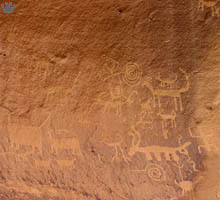
Petroglyphs, Chaco Canyon, New Mexico. |

Desert around Three Rivers Petroglyphs site, New Mexico. |
Part 2
Home
|